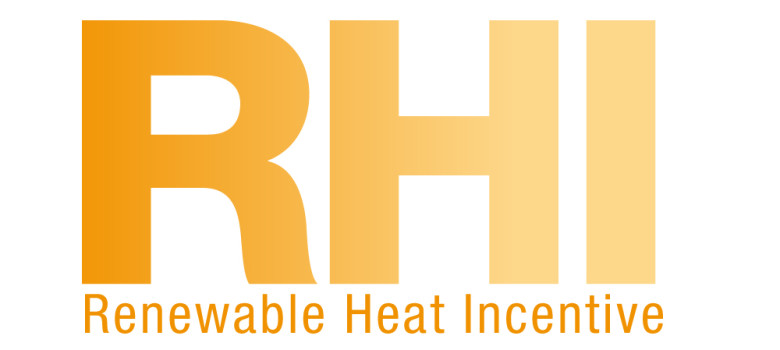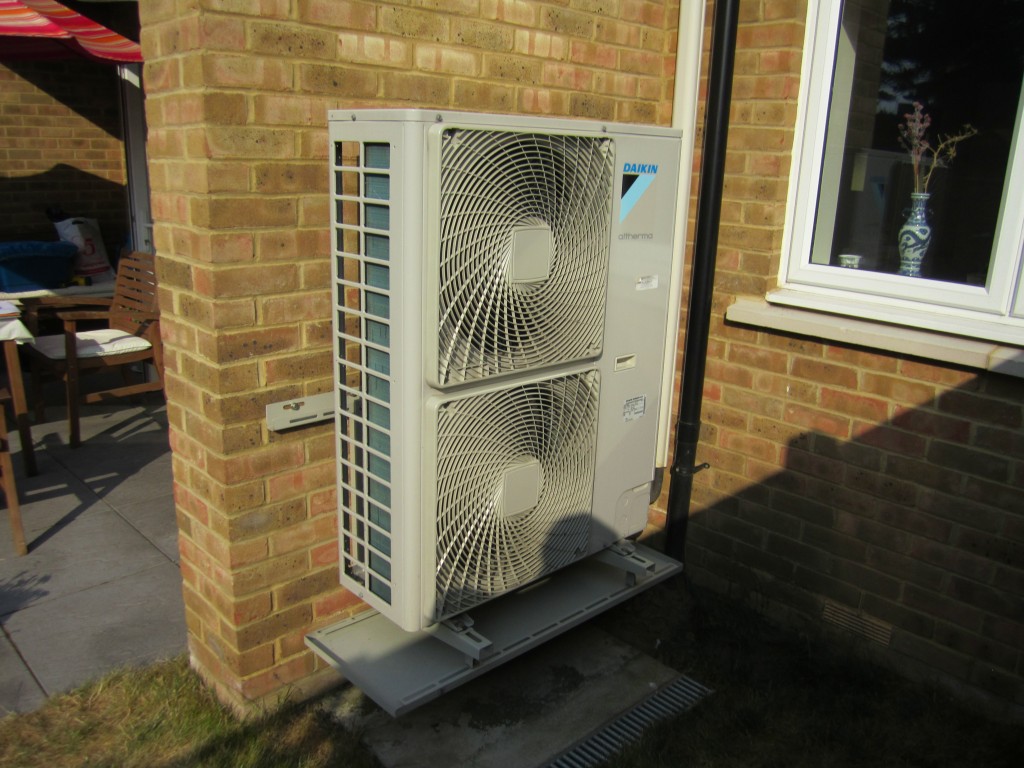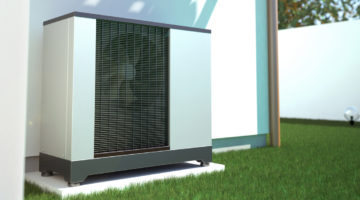
The Domestic Renewable Heat Incentive – what is it?
The Renewable Heat Incentive (RHI) is a government scheme that pays people that produce their own heating and hot water using renewable energy sources such as heat pumps or solar thermal panels.
The scheme has been launched in an effort to help the UK government meet its legal commitment to ensure 15% of the UK’s energy comes from renewable energy sources by 2020.
This scheme has been up and running in the commercial sector since November 2011, however the domestic RHI scheme kicked off in April 2014 for households in the UK. The Renewable Heat Incentive works in a similar way to the Feed-in Tariff (which is for domestic renewable electricity production); households in this case being paid based on the amount of renewable heat they produce.
There are currently 4 technologies that are eligible for the domestic renewable heat incentive
- Air source heat pumps (limited currently to those that heat water)
- Biomass boilers
- Ground/water source heat pumps
- Solar heating (also known as solar thermal – only flat plate and evacuated tube solar panels are eligible)
The payments will be made quarterly for seven years and should cover a significant proportion, if not all of the initial installation costs.
Domestic Renewable Heat Incentive tariffs
Each of the renewable technologies eligible for the renewable heat incentive have different RHI rates associated with them, mainly because the cost of installing the different technologies varies considerably and the RHI payments are designed to help cover some or all of the initial install cost.
On the whole, the RHI rates have increased very slightly in line with inflation except for biomass boilers and wood pellet stoves with back boilers which have dropped considerably – the rates below are correct as of September 2018. These can change from quarter to quarter, depending on how many people claim the payments. This is known as ‘digression’. You can find current rates here.
- 10.49p / kWh for air source heat pumps
- 6.74p / kWh for biomass boilers
- 20.46p / kWh for ground/water source heat pumps
- 20.66p / kWh for solar thermal
The payments are made on a quarterly basis and last for a total of 7 years. In addition, the tariff amounts are RPI index linked, so as inflation increases over time, the tariff rates above will increase with it. The RPI increases will be applied to the rates on 1st April each year.
RHI Payments will last a total of 7 years
Much like with the feed-in tariff, once you sign up to the RHI you will be locked in at the tariff rate that you initially get – so if you installed a Ground Source Heat Pump today you would get a payment of 20.46p per kWh of renewable heat you produced for the next 7 years (although it will increase with the the RPI each year).
Since there is a finite pot of money available for the RHI payments, it is likely the current tariffs will get smaller over time (again much like the solar feed-in tariff) therefore if you are considering installing a renewable heating technology it is worth moving quickly to ensure you get the highest payment rate!
The government do a quarterly review of the RHI scheme and adjust the tariff amounts in line with the total RHI budget so as to control the costs. Therefore if you install a renewable heating system you will get (and lock in) a better rate potentially than someone who installs a renewable heating measure 2 years down the line.
RHI payments are estimated based on heat demand rather than Metered
Tariff payments will be deemed rather than metered, which means they will estimate the heat demand of the property and base the RHI payment on that. This means that it is paramount to install a heating system that is correctly sized; because if you install a more expensive, oversized biomass boiler (that creates more than you require), you will be paid the same through the RHI and potentially won’t recoup the additional unnecessary investment.
Likewise, there are ways to maximise your RHI payments!
>>> Maximise you RHI payments <<<
Click on the titles below to see exactly how the RHI is calculated for biomass, heat pumps and solar heating.
For biomass boilers and wood pellet stoves, the RHI payment can be fairly easily calculated based on the heat demand of the property. This heat demand figure can be found right at the bottom of the Energy Performance Certificate (EPC) expressed in kWhs – so it is simply a case of multiplying £0.0674 x this number, which will give you the total annual payment.
>>> The cost of heating your home with gas vs electricity <<<
Example calculation for biomass:
For a home with a heat demand of 18,000kWh installing a biomass boiler would provide you with an RHI payment each year of:
18,000 x £0.0674 = £1213.20
For solar thermal, the MCS approved installer calculates the RHI payment. They will deem a figure that is the estimated contribution of the solar thermal to the home’s hot water demand, but the calculation is based on occupancy – the more people that reside in the property, the higher the payment – worth bearing in mind when you are speaking to your installer / green deal assessor.
For heat pumps (both ASHP and GSHP) the heat demand figure from the EPC is combined with the heat pumps estimated efficiency to calculate the RHI. Remember not all the heat produced by heat pumps is renewable, therefore only the part that is will receive RHI support.
The technical term for the estimated efficiency is known as the Seasonal Performance Factor (SPF) – and this tends to be somewhere between 2.5 and 4 (this is also sometimes referred to as the Coefficient of Performance or CoP). So an SPF of 3 for example, means that for every one unit (kWh) of electricity used, 3 units (kWh) of useful heat will be produced.
Therefore the RHI for heat pumps is calculated using the 2 formulas below:
1. Eligible Heat Demand = Total Annual Energy Demand x (1 – 1 / SPF)
2. Annual RHI = Eligible Heat Demand x RHI Tariff
Example calculation for Air Source Heat Pumps:
For a home with a heat demand of 25,000kWh installing an air source heat pump with a SPF of 3.5 the annual RHI payment would be:
Eligible Heat Demand = 25,000 x (1 – 1 / 3.5) = 17,857 kWh
Then multiply by RHI tariff (10.49p / kWh) = £1,873.20 per year
Only heat pumps with an SPF of 2.5 or more are considered renewable under the EU Renewable Energy Directive and only those that are considered renewable will be eligible for the RHI.
How long will my renewable heating investment take to pay back?
This is a difficult one to answer to be honest because it is so dependent on your home’s individual heat demand.
In terms of investment, you can expect to pay about £8,000 for an air source heat pump, £20,000 for a ground source heat pump, £8,000 for a biomass boiler and £4,500 for solar thermal.
If you can get an accurate view of the heat demand (from the EPC) then you should be able to calculate the annual payment from the domestic RHI, which multiplied by 7, will give you to the total payments to expect over this period.
With the investment figure and the total lifetime RHI return (comparing renewable heating to the next best alternative), you should be able to get a rough feel of the payback.
Eligibility requirements for the Domestic Renewable Heat Incentive
Renewable heating systems don’t come cheap – the domestic RHI makes these systems more affordable by offering a financial incentive based on the amount of heat they produce. However, there are quite strict eligibility criteria, so it is worth ensuring that you adhere to the rules to make sure you are entitled to the payments.
Which technologies are eligible for the domestic RHI?
As previously mentioned, the renewable heat incentive is available on installations of any of the following technologies:
- Air source heat pumps (limited currently to those that heat water)
- Biomass boilers
- Wood pellet stoves with back boilers
- Ground source heat pumps (this term also covers water source heat pumps, which are considered GSHP by RHI guidelines)
- Solar thermal (only flat plate and evacuated tube solar panels are eligible)
Download the full list of eligible installations here.
Who is eligible for the domestic RHI?
The scheme covers single domestic dwellings (as soon as the heating system is providing heat to more than one property, you would need to look at the non-domestic RHI). It is open to owner-occupiers, private landlords, registered providers of social housing, third party owners of heating system and self-builders.
Note to private and social landlords: you will need to agree with the tenants that an annual servicing visit will be required to ensure the system complies with the detail set of requirements and continues to be eligible for domestic RHI payments.
New builds are not eligible for the RHI – this means the renewable heating system was installed in the home before it was inhabited for the first time.
You heating system needs to be on the Government approved list
In order to ensure eligibility for the RHI, you must make sure the renewable heating system you get installed is listed on the Governments product eligibility list (PEL) – you can download this here.
MCS accreditation is a must!
To be eligible for the scheme, the installers must adhere to the European Standard EN 45011. The Microgeneration Certification Scheme (MCS) adheres to this standard, therefore as a rule of thumb you need to ensure that the team installing your renewable heating system are MCS accredited and the kit being installed is also MCS accredited.
Equivalent schemes to MCS do exist, but don’t simply take your installers word for it that they adhere to EN 45011 – check all the relevant paperwork before getting any work done.
Getting a Green Deal Assessment is no longer required!
In early 2016, the Government changed the elegibility requirements for the RHI and one of those changes involved scrapping the need for the Green Deal Report. The EPC is still a requirement though – this needs to be dated within the last 48 months – and will be used to calculate your RHI payments.
If your EPC recommends loft and cavity wall insulation it must be installed before you apply and you’ll then need to get a new EPC that no longer recommends these measures. The reason for this is that heat pumps and solar thermal tend to produce hot water at lower temperatures than traditional gas central heating systems. This means that radiators and underfloor heating will be operating at cooler temperatures compared to regular central heating systems, therefore it is very important the house is really well insulated prior to having them installed. The insulation process should bring the heating requirements of your home right down.
I have received other grants to pay for the technology. Do I still get the domestic RHI?
DECC confirmed in 2013 that any public funding paying for the domestic renewable heating installation would be deducted from RHI payments made. In addition, where an installation was not at least in part paid for by the owner, even where the installation was funded from a private source, that installation will not be eligible for the domestic RHI. An installation which has been part-funded by the owner will be eligible.
I have already installed my renewable heating system – Can I still claim the RHI?
You must apply to join the Domestic RHI within 12 months of the commissioning date of the renewable heating system. This can be found on the MCS certificate. The team that run the admin side of the RHI at DECC offer very little wriggle room here (99 times out of 100 – zero wiggle room!) so make sure you apply within the stipulated timeframes.
Technology Specific Eligibility Requirements
Heat pumps
- All heat pumps must have a Seasonal Performance Factor (SPF) greater than 2.5 to be eligible for the RHI. Heat pumps installed by legacy applicants will automatically be considered to have an SPF of 2.5, and will require a full assessment by an MCS installer to prove a higher SPF (which would lead to higher RHI payments – so may well be worth doing!)
- If a heat pump is installed alongside another space heating system then a meter will need to be installed to gauge exactly how much heating is coming from the heat pump. RHI payments will be based on these meter readings rather than the estimated heat demand for the property.
Biomass boilers/wood pellet stove with back boiler
- If a biomass boiler is installed alongside another space heating system then a meter will need to be installed to gauge exactly how much heating is coming from the biomass system. RHI payments will be based on these meter readings rather than the estimated heat demand for the property.
- New installations of biomass boilers will need to meet strict air quality standards in relation to particulate matter and oxides of Nitrogen – as mentioned previously – legacy applications will not need to adhere to this.
- If the air quality standards change in the future, you do not need to concern yourself with your installed boiler not meeting the standards.
- To be eligible for the RHI, the fuel needs to be sourced from a supplier registered on the approved supplier list.
How do I apply for the domestic RHI?
The application process for the domestic Renewable heat Incentive is fairly simple, however numerous pieces of evidence (installation certificates, EPC, and photos for example) are required for the submission.
Since the RHI is funded out of a public kitty (through tax payers), it is important that the money being spent to subsidise the scheme is under the right level of scrutiny, hence the volume of evidence required.
Applying for the domestic RHI
Applications for the domestic RHI are made through the OFGEM website through the My RHI portal
>>> Log in to the ‘My RHI’ Portal’ <<<
However if you find the thought of carrying out this process a little too onerous, there are third party companies offering to complete this on your behalf, although obviously there is a charge for this service. The process genuinely is pretty easy though, so in our opinion certainly worth giving it a try yourself before getting this kind of company in!
The RHI is now closed to legacy applicants
If you are a new applicant (so the installation took place after the scheme launched), then you will be able to claim the RHI straight away.
Unfortunately the scheme has now closed to legacy applicants (i.e. those who installed their renewable heating system prior to the scheme going live in April 2014).
Can the set RHI levels be changed once I have applied?
The headline RHI tariff figures do change, like we have already seen for the biomass renewable heat payments, and as time goes on and the RHI budget gets used up, we expect further drops in the tariff to take place. The Government will look at the tariff levels every 3 months and adjust them accordingly – however if you are receiving the RHI – you have locked in to whichever rate was agreed at the beginning – this is the rate that you will receive for 7 years (although it will increase with RPI each year).
Is there anything else I need to know?
The government will run a “Metering and Monitoring Service Package”, which consumers can volunteer for. Data collected under this scheme will be shared by the Department of Energy & Climate Change (DECC) with the installer and consumer. Domestic RHI recipients who volunteer will receive £230 per year to have their heat pump installation monitored and £200 per year to have their biomass installation monitored.
Hybrid systems installed with a gas boiler or oil boiler will need to be metered, except solar thermal systems.
The system will need to be serviced annually in accordance with manufacturer’s instructions to ensure efficient running of the system.













This is a great article – really helpful. I want to get a heat pump installed and was wondering what kind of return I could expect. This lets me calculate perfectly. Thanks GreenAge
I had a air source heat pump in my home (it is 90s build) and it is absolutely fantastic addition. The heat pump was put in to replace an old oil boiler 2 years ago. There were rumours of the RHI back then, but nothing concrete. I am so happy I made the investment regardless of the RHI to be honest, but this should actually help cover the install cost too – so for people considering installing a heat pump now, it is an absolute no brainer.
I came across your website as it was recommended by the local energy action group here in Muswell Hill. My husband and I also like your website. We moved into our 12 bedroom property over a year ago and since then we have had thousands spent on refurbishment. Our local boiler installer installed 5 air source heat pumps and told us we would get this money back from the government grant. When we did the EPC it gave us a rating of 45 and were told we needed to get to a band D and also have an MCS certificate. We went back to the installer but he hasn’t returned any of our calls and it has been 2 months. We have decided to take the matter with trading standards. Could I get someone else to produce for us the MCS certificates and what else do we need to do to the house to get it up to scratch from an energy perspective? Any help would be much appreciated.
Hi Milly, we new about the MCS thing from a friend who went through a similar thing by the sound of things. She did manage to get a new MCS certificate report completed, but the company used charged her £499. I think to be honest though it was the choice between no RHI and a few thousand pounds a year it was definitely worth it! In terms of EPC, was it done before or after the heat pump was installed, because the property should now be seen as more efficient having had the heat pump installed, so the rating would be higher and this will allow you to get the RHI!
Hope that helps.
This is really helpful thank you. I have just had biomass installed after being told about the financial return. It is unbelievable, I assume it is just a matter of time before people clock on to the returns and it like the solar feed in tariff it drops, but I would strongly recommend people to look at it while they can!
I’ve been following your blogs for a while and whilst I enjoy most of the topics you explore on energy efficiency, I don’t agree on your editorial take on renewables and the renewable heat incentive. The renewable heat incentive and the feed-in tariff are essentially subsidies paid into the pot by everyone, which means the poorest in our society are essentially subsidising pieces of kit (biomass boilers, air source heat pumps, solar tubes, etc) installed by the richest in our society. How can you defend this status-quo?
I think you are completely missing the point Mike, all new technologies need a bit of help to get going. Think of how much solar panels were when they were first released – more than £4,000 per KW in some cases. Now they are just £1500 per kW (and you can get them cheaper than that). The Renewable heat incentive is rewarding early adopters. In some cases the RHI payments were too big, but most should be able to get a loan if they were that interested in installing them and there are schemes like the Green Deal which I know aren’t great, but again offer a financing mechanism.
While I see you point, if you considered the leg ups given to the oil industry get even now, renewables deserve their chance to blossom!
Hi Mike, I don’t quite agree with what you are saying. This article is a factual representation of the Renewable Heat Incentive scheme – no where in these sections does it try to push people towards these technologies.
Yes, it is true the Renewable Heat Incentive is paid for by central Treasury funds, but these payments are constantly being reviewed and digressed as we move forward to ensure it provides a good deal for the taxpayer. For example the support offered to biomass boilers has been reduced twice – Dec 31st 2014 by 10% and then a further 20% in April 2015.
But also, it is not true the richest that benefit from these schemes – for example we have “rent a roof” solar PV schemes and subsidised biomass boilers have helped 1000s of low and middle income customers who can’t afford the upfront cost for these technologies enjoy free electricity and low carbon sources of heating.
Kay you are just wrong. If the industry can’t support it self then why take valuable resources which can be spent on transport and health card for unproven technologies.
“Good deal for the taxpayer” you are having a laugh. From what I have read on here you want the poorest to be hardest hit. I’ve read about the “rent a roof” schemes and all they do it take down the value of properties where they are installed as the charge sits on the land registry until the contract is paid off. Hardly a good deal the Green Deal is, when all you are asking is for those that struggle to take up more debt and pay more interest leaving them in a dire financial situation. That’s what I mean about defending the status quo.
Hi Mike, so you reckon the oil industry had no leg up back in the day? Have a read of this – http://www.motherjones.com/politics/2014/04/oil-subsidies-renewable-energy-tax-breaks
I read today that the CO2 levels have now reached a global average of 400ppm, that is a rise of more than 120 parts per million since pre-industrial times. Worse is that halve of that has occurred since 1980. It is estimated the polar ice caps are going to be gone within the next 20 years. So we need to take action and these efficient heating systems are at least a start!
The domestic renewable heat incentive is there to encourage uptake – I don’t see much harm in that.
Key, that’s rubbish and typical Global Warming Alarmist gibberish. Are you sure you don’t work or get funded by the IPCC?? Anyway the earth is cooling and here is the evidence http://www.forbes.com/sites/peterferrara/2012/05/31/sorry-global-warming-alarmists-the-earth-is-cooling – by a prominent scientist and their support community.
I agree with energy efficiency like solid wall insulation and loft insulation, which takes consumption down by 60% but what is the point of wasting money when we could spend it for other means. While I don’t believe global warming is happening I am a supporter of cutting waste and preserving natural resources. But to cut oil and gas tomorrow would mean the poorest will be hit the hardest!
Hello Mike, climate change is happening! The view from the “deniers” is a minority view and is not underpinned by any “hard” and material evidence. Anyway to move back to what the underlying message of this article is one of factual representation of a Government subsidy that describes how consumers can get support for installing low-carbon technologies. Actually the technologies are proven, for instance the air source heat pump is based on technology from 30-40yrs ago. Biomass boilers are incredibly efficient and solar thermal panels do wonders for your hot water consumption.
and how in heavens name could biomass be considered Green given the co 2 and particulates pouring out not to mention the chopping of trees…look at Drax consuming £1m a day of chips…far worse that natural gas boilers which are pretty clean and very efficient
And my two pennies worth! Heat pumps are essentially refrigeration units (with a compressor) so are built to run and run. They should last far longer than the 12 years a new boiler does according to DEFRA!
Biomass boilers are a slightly newer technology so they are unlikely to last as long but still the big companies have now got involved.
The RHI is a fantastic mechanism to help adoption of these technologies so if you do need a new heating system it is definitely worth looking at some of the technologies discussed above!
This is a useful guide. With the RHI just about the last energy saving scheme the Government are supporting I would suggest anyone considering installing a new heating system to look into it.
Hi, thanks for your comment. I agree – if the RHI works (as in the financial return is the same / higher than the install cost and you are replacing a more expensive fuel type then the renewable heat incentive is definitely worth taking a look at.
Hello
I’m looking at an ASHP for my first floor flat which was built in 1960 and has uninsulated cavity walls. The rules seem to say I need to get this done if its a recommendation on my EPC which it is. However half the block is council and I cannot just insulate my part. Is there anyway round this.